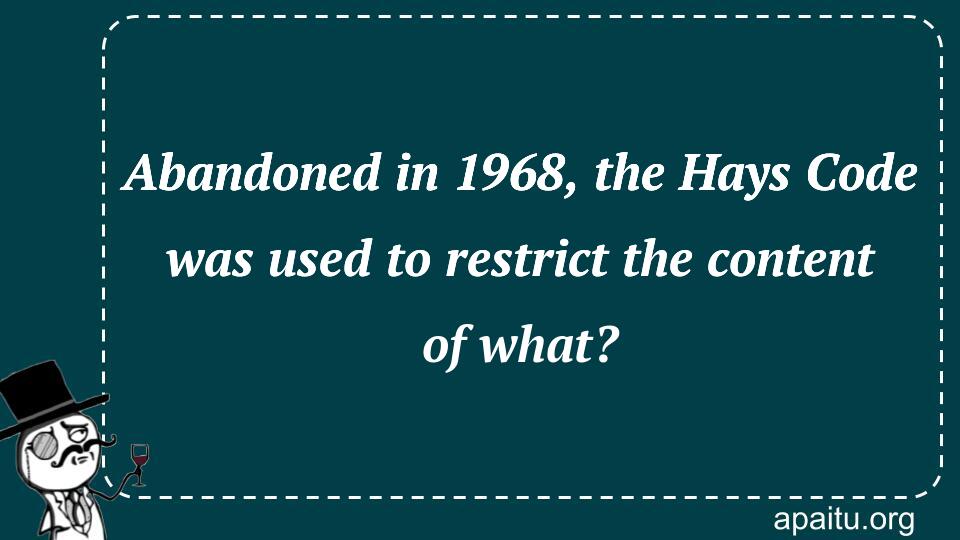Question
Here is the question : ABANDONED IN 1968, THE HAYS CODE WAS USED TO RESTRICT THE CONTENT OF WHAT?
Option
Here is the option for the question :
- Movies
- Music
- Literature
- Street art
The Answer:
And, the answer for the the question is :
Explanation:
From the 1930s until the late 1960s, all motion pictures produced in the United States were required to adhere to a set of rules and principles known as the Hays Code. The code prohibited behaviour that was sexually explicit as well as the promotion of ‘negative values,’ which included the use of profanity. During the 1960s, filmmakers tested the limits of the code, and as a result, the culture was shifting in a way that ultimately led to the code’s formal abandonment in 1968. The current system of ratings, which is focused on content rather than the old method, took its place.

The Hays Code, also known as the Motion Picture Production Code, was a set of guidelines that regulated the content of American movies from the 1930s to the late 1960s. The code was enforced by the Motion Picture Association of America (MPAA) and was intended to ensure that movies were morally and socially responsible. However, by the late 1960s, the code had become outdated and was abandoned in favor of a more liberal rating system.
The Hays Code was named after Will Hays, the president of the MPAA from 1922 to 1945. The code was developed in response to concerns about the content of movies, which were seen as too violent, sexually suggestive, and morally questionable. The code provided detailed guidelines for filmmakers, outlining what was and was not acceptable in terms of content.
Under the Hays Code, movies were required to portray “correct standards of life,” which meant avoiding depictions of violence, sex, and other potentially controversial topics. The code also required that movies promote “good taste” and “respect for the law,” and it prohibited the use of profanity and blasphemous language.
The Hays Code was strictly enforced, and filmmakers who violated the code risked having their movies banned or heavily censored. However, many filmmakers found ways to work around the code, using symbolism and innuendo to convey controversial themes and ideas.
By the 1960s, the Hays Code had become increasingly outdated. The code’s restrictions on content were seen as overly restrictive, and many filmmakers felt that the code was stifling creativity and artistic expression. In 1968, the MPAA abandoned the Hays Code in favor of a more liberal rating system that allowed for greater artistic freedom.
the Hays Code is remembered as a relic of a bygone era in American cinema. While it was intended to promote morality and social responsibility, it ultimately served to stifle creativity and limit the range of ideas and themes that could be explored in movies. The abandonment of the code in 1968 marked a turning point in American cinema, ushering in a new era of artistic freedom and experimentation that continues to this day.